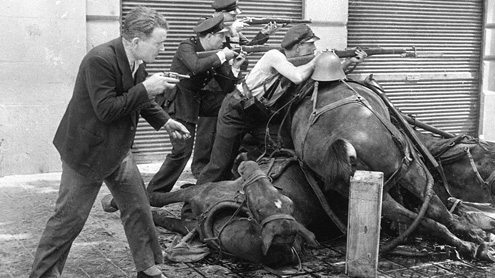 On April 26, 1937, German planes bombed the Basque town of Guernica, killing around 1,000 people. Undertaken as part of Germany’s involvement in the Spanish Civil War, the bombing was intended to cause terror. But as sometimes happens, there was a boomerang effect.
On April 26, 1937, German planes bombed the Basque town of Guernica, killing around 1,000 people. Undertaken as part of Germany’s involvement in the Spanish Civil War, the bombing was intended to cause terror. But as sometimes happens, there was a boomerang effect.
For significant sections of western opinion, the brutality of what happened in Guernica had a galvanizing effect, bringing them off the fence to a position contrary to what the bombers intended. Immortalized by a Pablo Picasso painting, Guernica became a symbol of the fight against fascism.
But let’s back up a bit.
The Spanish Civil War (1936-39) was a while in the making. Politically and economically backward, Spain was wracked by poverty, conflict and violence. It had a history of authoritarian government and trust between social classes was low.
So after the left-wing Popular Front won a razor-thin victory in the February 1936 election, right-wing fears went over the top. There would be anarchy, strikes, land seizures and more. What happened in communist Russia would happen in Spain. Or so the story went.
When civil war broke out on July 17, it pitted those loyal to the elected government (left-wing Republicans) against the rebels (right-wing Nationalists). But what was initially conceived as an efficient military coup turned out to be much trickier.
In fact, the war went on for almost three years. And it was an enormously vicious conflict, with atrocities common on both sides.
There was also a distinct element to the Republican atrocities, specifically, an anti-clericalism aimed at the Catholic church.
This anti-clericalism was driven by the clergy’s political disposition – generally anti-socialist and especially anti-communist – and the perception that the church was rich and historically privileged. Substantial numbers of bishops, monks and priests were murdered. Even nuns weren’t necessarily safe.
This, of course, generated an anti-Republican backlash in the Catholic community worldwide. American historian Richard Gid Powers has written about the efforts of Catholic groups like the Knights of Columbus to drum up Nationalist support in order to combat the “war against the Church in Spain.” And lurid tales proliferated of priests having their throats ripped out and nuns being forced to swallow their rosary beads.
A common perspective on the conflict sees it as a tragic prelude to democracy’s subsequent war against fascism, the Second World War. And there’s significant validity to that. After all, however tenuous its plurality might have been, the government was legitimately elected and the Nationalist rebellion against it was therefore an undemocratic usurpation.
But there’s also a complementary perspective, which views it as a proxy war between competing European ideologies. The left-wing Republicans were assisted by Josef Stalin’s Soviet Union, while the right-wing Nationalists were supported by arms and men from Fascist Italy and Nazi Germany (hence the German bombing of Guernica).
And in addition to regular soldiers, there were thousands of foreign volunteers, particularly the International Brigades fighting on the Republican side. These brigades came from all over – more than 40 countries – and it was dangerous work. More than one-third of the approximately 2,500 American volunteers may have been killed.
And for Republicans, the Nationalists weren’t the only worry. As George Orwell discovered – and recounted in Homage to Catalonia (1938) – the Stalinists, although ostensibly on your side, might also have you in their sights.
Orwell, a democratic socialist, went to Spain to fight fascism. But he found himself a target in the May 1937 purge orchestrated by Stalin’s secret police. He was, the allegation went, guilty of “rabid Trotskyism.”
It was terrifying and left a permanent impression. Unlike many of his western intellectual contemporaries, Orwell – although still a man of the left – was now fully inoculated against subservience to Moscow.
Eventually, the Republicans were ground down. Barcelona fell in January 1939 and Madrid did likewise in March. The war, if not the killing, was effectively over.
And although Stalin cynically used the Republicans, that didn’t necessarily dim their admiration. For instance, the Republican communist Dolores Ibarruri – famous as La Pasionaria – remained forever devoted.
But Francisco Franco, the Nationalist leader and subsequent dictator, was more parsimonious about loyalty to his benefactors. When the Second World War came calling, he opted to keep Spain out of the fighting.
Troy Media columnist Pat Murphy casts a history buff’s eye at the goings-on in our world. Never cynical – well perhaps a little bit.
The views, opinions and positions expressed by columnists and contributors are the author’s alone. They do not inherently or expressly reflect the views, opinions and/or positions of our publication.


